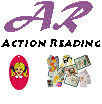
|
ACTION-READING The original Cureton Method |
Presented by Jeanie Eller America's Reading Teacher |
||||||
|
|
||||||||
Common Core Standards |
||||||||
|
FUNdamentals Home Phonics Tutorial by Action Reading is the fastest, most fun way to use Language Arts Common Core Standards to insure that students become fluent, independent readers. FUNdamentals uses songs, games, exercises and activities along with direct, intensive, systematic instruction of phonics and the principles of the English Language. “The more senses you use – the faster you learn.” |
||||||||
|
||||||||
|
|
||
|
Kindergarteners:
|
Grade 1 students:
|
Grade 2 students:
|
|
3. Know and apply grade-level phonics and word analysis
skills in decoding words.
a. Demonstrate basic knowledge of one-to-one letter-sound
correspondences by producing the primary or many of the most frequent sound for
each consonant.
b. Associate the long and short sounds with common spellings
(graphemes) for the five major vowels.
c. Read common high-frequency words by sight (e.g.,
the, of, to, you, she, my, is, are, do, does).
d. Distinguish between similarly spelled words by identifying
the sounds of the letters that differ. (K.RF.3)
|
3. Know and apply grade-level phonics and word analysis
skills in decoding words.
a. Know the spelling-sound correspondences for common
consonant digraphs.
b. Decode regularly spelled one-syllable words.
c. Know final -e and common vowel team conventions for
representing long vowel sounds.
d. Use knowledge that every syllable must have a vowel
sound to determine the number of syllables in a printed word.
e. Decode two-syllable words following basic patterns
by breaking the words into syllables.
f. Read words with inflectional endings.
g. Recognize and read grade-appropriate irregularly
spelled words. (1.RF.3)
|
3. Know and apply grade-level phonics and word analysis
skills in decoding words.
a. Distinguish long and short vowels when reading regularly
spelled one-syllable words.
b.
Know spelling-sound correspondences for additional common vowel teams.
c. Decode regularly spelled two-syllable words with
long vowels.
d. Decode words with common prefixes and suffixes.
e. Identify words with inconsistent but common spelling-sound
correspondences.
f. Recognize and read grade-appropriate irregularly
spelled words. (2.RF.3)
|
|
Fluency
|
||
|
4. Read emergent-reader texts with purpose and understanding.
(K.RF.4)
|
4. Read with sufficient accuracy and fluency to support
comprehension.
a. Read on-level text with purpose and understanding.
b. Read on-level text orally with accuracy, appropriate
rate, and expression on successive readings.
c. Use context to confirm or self-correct word recognition
and understanding, rereading as necessary. (1.RF.4)
|
4. Read with sufficient accuracy and fluency to support
comprehension.
a. Read on-level text with purpose and understanding.
b. Read on-level text orally with accuracy, appropriate
rate, and expression on successive readings.
c. Use context to confirm or self-correct word recognition
and understanding, rereading as necessary. (2.RF.4)
|